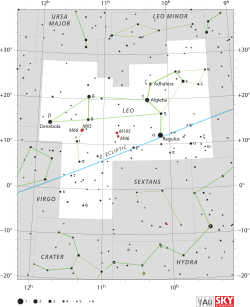Eta Leonis
From Wikipedia, the free encyclopedia

Location of η Leo (circled) | |
| Observation data Epoch J2000 Equinox J2000 | |
|---|---|
| Constellation | Leo |
| Right ascension | 10h 07m 19.9523s[1] |
| Declination | 16° 45′ 45.592″[1] |
| Apparent magnitude (V) | 3.511[1] |
| Characteristics | |
| Spectral type | A0 Ib[1] |
| U−B color index | -0.21 |
| B−V color index | -0.03[2] |
| Variable type | Eclipsing binary |
| Astrometry | |
| Radial velocity (Rv) | 3.3 [1] km/s |
| Proper motion (μ) | RA: -1.94 [1] mas/yr Dec.: -0.53 [1] mas/yr |
| Parallax (π) | 1.53 ± 0.77[3] mas |
| Distance | approx. 2,000 ly (approx. 700 pc) |
| Absolute magnitude (MV) | -5.60 |
| Details | |
| Mass | 10.8 [4] M☉ |
| Radius | 49.7 R☉ |
| Luminosity | 18,800 L☉ |
| Temperature | 9,770 K |
| Metallicity | -0.04 Fe/H[5] |
| Rotation | 23 km/s [6] |
| Age | 3.5×107 [4] years |
| Other designations | |
| Database references | |
| SIMBAD | data |
Eta Leonis (η Leo, η Leonis) is a fourth-magnitude star in the constellation Leo. Since 1943, the spectrum of this star has served as one of the stable anchor points by which other stars are classified.[7]
Properties
Eta Leonis is a white supergiant with the stellar classification A0Ib. Though its apparent magnitude is 3.51, making it a relatively dim star to the naked eye, it is 5,600 times more luminous than the Sun,[4] with an absolute magnitude of -5.60. The Hipparcos astrometric data has estimated the distance of Eta Leonis to be roughly 700 parsecs[3] from Earth, or 2,000 light years away.
There is evidence suggesting that Eta Leonis is part of a binary star system.[4]
See also
- Lists of stars in the constellation Leo
- Class A Stars
- Binary Star
References
- ↑ 1.0 1.1 1.2 1.3 1.4 1.5 1.6 "SIMBAD query result: eta Leo -- Variable Star". Centre de Données astronomiques de Strasbourg. Retrieved 2010-05-11.
- ↑ Nicolet, B. (1978). "Catalogue of homogeneous data in the UBV photoelectric photometric system". Astronomy and Astrophysics (PDF) 34: 1–49. Bibcode:1978A&AS...34....1N.
- ↑ 3.0 3.1 Perryman, M. A. C. et al. (1997), "The Hipparcos Catalogue", Astronomy & Astrophysics 323: L49–L52, Bibcode:1997A&A...323L..49P
- ↑ 4.0 4.1 4.2 4.3 Professor James B. (Jim) Kaler. "ETA LEO (Eta Leonis)". University of Illinois. Retrieved 2010-05-11.
- ↑ Cenarro, A. J.; Peletier, R. F.; Sánchez-Blázquez, P.; Selam, S. O.; Toloba, et al (2007). "Medium-resolution Isaac Newton Telescope library of empirical spectra - II. The stellar atmospheric parameters". Monthly Notices of the Royal Astronomical Society (PDF) 374 (2): 664–690. arXiv:astro-ph/0611618. Bibcode:2007MNRAS.374..664C. doi:10.1111/j.1365-2966.2006.11196.x.
- ↑ Royer, F.; Grenier, S.; Baylac, M.-O.; Gómez, A. E.; Zorec, J. (2002). "Rotational velocities of A-type stars in the northern hemisphere. II. Measurement of v sin i in the northern hemisphere". Astronomy and Astrophysics (PDF) 393 (3): 897–911. arXiv:astro-ph/0205255. Bibcode:2002A&A...393..897R. doi:10.1051/0004-6361:20020943.
- ↑ Garrison, R. F. (December 1993), "Anchor Points for the MK System of Spectral Classification", Bulletin of the American Astronomical Society 25: 1319, Bibcode:1993AAS...183.1710G, retrieved 2012-02-04
External links
- Jim Kaler's Stars:Eta Leo
| ||||||||||||||||||||||||||
This article is issued from Wikipedia. The text is available under the Creative Commons Attribution/Share Alike; additional terms may apply for the media files.